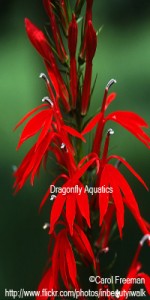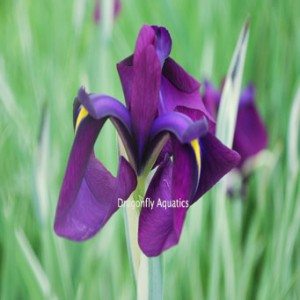Its ice everywhere.....but at least its February so its almost over. I will say its a pretty site but I still prefer the green color over the white! I look outside and imagine pictures like this...
The plants continue to grow nicely in the greenhouses and while standing in there you almost can forget what's going on outside. Call it an escape from reality. The marsh marigolds are starting to bloom alot and I must say they are really nice plants this year.
The snow storm isn't over yet so we are all in a holding pattern....waiting on the next blast to come through. Whether it will be ice or snow remains yet to be determined. So I will continue to think of all the plants growing and start to update our store to share the plants with you that we will be offering this year.
Official its Fall now.....the other day it was 88 degrees out....today its 52 degrees and looks like fall. Chill in the air, cloudy skies and rain off and on. I still need a few more nice warm days before settling in for the dreaded winter months. I still have to prepare my pond for winter....I always seem to let it go until the last minute. Hopefully I get those few more warm days or I'll be sorry.
I decided to share some preparation tasks for your pond before the weather changes and we all settle in for the winter. This will help improve your pond water and hopefully help make the spring clean up less work.
FALL/WINTER POND MAINTENANCE TIPS
1. Before winter arrives, you will want to make sure your pond and filtering system are clean to ensure good water quality throughout the winter months. With the arrival of fall it is wise to do a partial water change to remove any built up contaminants to improve water quality. Partial water changes need to be made before water temperatures fall below 60 degrees to minimize fish stress. Adding pond salt at this time will improve the slime coating of fish, to help them ward off disease and parasites.
2. Before the leaves begin to fall, cover your pond with one of our pond nets. The goal is to try and keep the pond as clean as possible for the winter months. Leaves will sink to the bottom of the pond and rot, causing excess carbon dioxide and hydrogen sulfide. After the first frost, take out any floating plants, as these will begin to decay. Trim back hardy lilies and bog plants and place below the freeze line.
3. Switch to Microbe-Lift Autumn/Winter Prep. This will help break down organic material in the pond before winter sets in. Microbe-Lift Autumn/Winter Prep helps accelerate the decomposition of leaves, scum, sediment and other organic matter during the fall and throughout the winter months. Also, Microbe-Lift Autumn/Winter Prep helps to maintain a healthy immune system for your fish during the winter months. Microbe-Lift Autumn/Winter Prep will help jump-start your pond to a healthier environment in the spring.
4.Reduce your fish feeding as the water temperatures drop below 60 degrees. Start feeding your fish a couple of times a week. We recommend switching to a wheat germ based fish food formulated for fall and spring feeding. When water temperatures drop below 60 degrees, the metabolism of your fish slow down. Both Tetra-Pond Spring/Fall and Microbe-Lift Cold Weather fish food are highly digestible cool weather diets that are made with less protein, but contain wheat germ, which is easily digested. They also contain higher levels of fat, which help your fish survive their winter hibernation. When water temperatures reach 50 degrees, stop feeding your fish completely. Feeding at water temperatures below 50 degrees can possibly kill your fish. A pond thermometer is a must have. This will help you in determining when to stop feeding your fish and will also help to know when to begin feeding your fish in the spring. Its also a good idea to know your water temperature for those adding tropical pond plants to your pond in the spring.
5.Adding Microbe-Lift Barley Straw Extract will help control string algae throughout the fall and winter months. Barley Straw Extract is an effective and eco-friendly way to reduce algae. Unlike algaecides, which are ineffective in water temperatures below 50 degrees, Microbe-Lift Barley Straw Extract will continue to control algae throughout the winter months.
6.Before freezing temperatures begin, install a pond de-icer. Ponds covered with ice do not allow toxic gases to escape causing fish loss. A pond de-icer will keep a section of your pond open to allow oxygen and gas exchange.
7.During the winter removing snow from the surface of the pond will help submerged plants and microscopic aquatic plants to continue to produce oxygen as long as light penetrates through the ice. Insufficient light, along with the decomposition of plant and leaf debris may result in insufficient oxygen for the fish, causing them to suffocate. Removing the snow from a portion of your surface area will reduce the likelihood of this occurring.
 I thought I'd publish this article we wrote last year again. When trying to get some of the bog plants started in your ponds its best to start them out slowly in the water, since most of them are swamp like plants. They can tolerate a few inches above their pot once they are established and growing. When growing them in our greenhouses we have them growing in two inch net pots in bins that have about one inch of water in them so the water is keeping their roots wet.
I thought I'd publish this article we wrote last year again. When trying to get some of the bog plants started in your ponds its best to start them out slowly in the water, since most of them are swamp like plants. They can tolerate a few inches above their pot once they are established and growing. When growing them in our greenhouses we have them growing in two inch net pots in bins that have about one inch of water in them so the water is keeping their roots wet.
Here's the article.
I've been wanting to write something on this subject for some time now. Finally, I have a bit of time to address the subject of water depth for bog plants and marginal plants. Simply put, bog plants like their "feet" wet. Translation....roots and soil moist at all times. When the plants are first planted, this is especially important. Many of the bog plants will take deeper water as they mature and spread. But, when you first receive your bog plants, you will have better success if you place them where there is no more than a half inch or less of water above the soil line. Think of the marshes and swampy areas, you have passed while traveling down the road. These natural reservoirs, fill during the rainy season and will dry out during dry spells. The plants adjust to the varying water depth and grow and spread rapidly. If you have a question on a particular plant, just ask and we will be happy to help you plant and grow beautiful marginal and bog plants.
 Once your hardy marginal plants begin to brown, usually after the first hard frost, prune back excess foliage and discard any decaying material, so it does not compromise the water quality over the winter months. Potted bog plants such as Pickerel, Thalia Dealbata, and Japanese Variegated Iris should be placed at a sufficient depth to avoid freezing the crown of the plant. Most of the other hardy bog plants can be left as they are and will return the following spring.
Once your hardy marginal plants begin to brown, usually after the first hard frost, prune back excess foliage and discard any decaying material, so it does not compromise the water quality over the winter months. Potted bog plants such as Pickerel, Thalia Dealbata, and Japanese Variegated Iris should be placed at a sufficient depth to avoid freezing the crown of the plant. Most of the other hardy bog plants can be left as they are and will return the following spring.